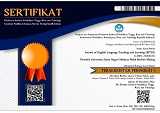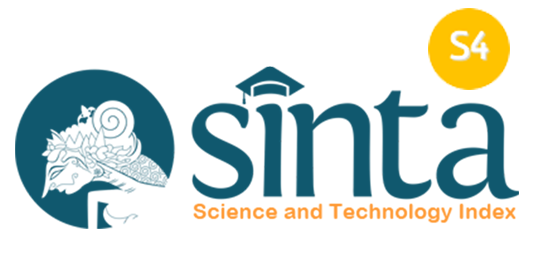The occurrence of code-switching in English as foreign language Classroom: An analysis of teacher’s and students’ conversations
Abstract
Keywords
Full Text:
PDFReferences
Bhatia, T. K., & Ritchie, W. C. (Eds.). (2008). The Handbook of Bilingualism. John Wiley & Sons.
Clyne, M. (2017). Multilingualism. The Handbook of Sociolinguistics, 301-314.
Fachriyah, E. (2017). The functions of code switching in an English language classroom. Studies in English Language and Education, 4(2), 148-156. http://dx.doi.org/10.24815/siele.v4i2.6327
Fanani, A., & Ma’u, J. A. R. Z. (2018). Code Switching and code mixing in English learning process. Ling Tera, 5(1), 68-77. http://dx.doi.org/10.21831/lt.v5i1.14438
Fitriana, R. (2023). The influence of cultural characteristics in writing English: Perspectives from multilingual learners. Journal of English Language Teaching and Learning (JETLE), 4(2), 114-124. https://doi.org/10.18860/jetle.v4i2.20679
Hamers, J. F., Blanc, M., Blanc, M. H., & Hamers, J. F. (2000). Bilinguality and Bilingualism. Cambridge University Press.
Hamid, S. M. (2016). Code-switching between the teachers and the students of the conversation. Exposure, 5(2), 174-195. http://dx.doi.org/10.26618/ejpbi.v5i2.846
Jalil, S. A. (2009). Grammatical perspectives on code-switching. ReVEL, 7(13), 1-11. http://www.revel.inf.br/files/artigos/revel_13_grammatical_perspectives_on_code_switching.pdf
Jingxia, L. (2010). Teachers' Code-switching to the L1 in EFL classroom. The Open Applied Linguistics Journal, 7(10). http://dx.doi.org/10.2174/1874913501003010010
Kim, E. (2006). Reasons and motivations for code-mixing and code-switching. Issues in EFL, 4(1), 43-61. https://www.academia.edu/35271736/Reasons_and_Motivations_for_Code_Mixing_and_Code_Switching
Moetia, M. (2018). Code mixing and code switching in the classroom interaction. English Education Journal, 9(2), 229-242. https://jurnal.usk.ac.id/EEJ/article/view/11530
Murtiningsih, S. R., Munawaroh, M., & Hidayatulloh, S. M. M. (2022). Code-switching in EFL Classrooms: Factors influencing teachers to use code-switching and its types used in the classrooms. Journal on English as a Foreign Language, 12(2), 318-338. http://dx.doi.org/10.23971/jefl.v12i2.3941
Muysken, P. (2020). Code-switching and Grammatical Theory. In The bilingualism reader (pp. 280-297). Routledge.
Octaberlina, L. R. (2022). Interlanguage analysis of Indonesian young learner’s English acquisition. PANYONARA: Journal of English Education, 4(2), 175-189. https://doi.org/10.19105/panyonara.v4i2.6954
Parangu, K. A., Ratih, E., Prasetyaningrum, S. T. (2020). Introducing Javanese culture through selected texts in EFL class. Journal of English Language Teaching and Learning (JETLE), 2(1), 31-36. https://doi.org/10.18860/jetle.v2i1.10532
Poplack, S. (1980). Sometimes I will start a sentence in Spanish y Termino en Espanol: Toward a typological of code-switching. Linguistics, 18, 581-616. http://dx.doi.org/10.1515/ling.1980.18.7-8.581
Rahmawati, R., & Rohmana, W. I. M. (2023). Interlingual and intralingual interferences in EFL Students’ Writing: A case study at Aphrodite English Club. Beyond Words, 11(1), Article 1. https://doi.org/10.33508/bw.v11i1.4887
Rinda, R. K., & Lestari, L. A. (2014). A Study of Code-switching of teacher talk on trainee teacher in PPL II Program of State University of Surabaya. RETAIN, 2(1), 1-10. https://ejournal.unesa.ac.id/index.php/retain/article/view/8915/8912
Setyana, G. P., Budianto, L., Putera, A. A. (2022). Investigating students’ speaking anxiety factor in bilingual program at Junior High School students. English Edu: Journal of English Teaching and Learning, 1(1), 1-8. https://doi.org/10.18860/jetl.v1i1.1617
Susilo, R. (2015). Code-switching in EFL classroom by English teacher of SMP Negeri 2 Rembang. Retain : Journal of Research in English Language Teaching, 3(2). Retrieved from https://ejournal.unesa.ac.id/index.php/retain/article/view/11787
Syahruzah, J. K. (2023). Students’ perception of teacher in using bilingual in EFL classroom: Indonesian context. Journal of English Language Teaching and Learning (JETLE), 5(1), 53-39. http://dx.doi.org/10.18860/jetle.v5i1.20653
Ulfah, N. M., Tsuraya, A. S., & Risal, R. (2021). The use of code-switching by English teachers in foreign language classroom. English Language, Linguistics, and Culture International Journal, 1(1), 11-23. https://doi.org/10.24252/elstic-ij.v1i1.22001
Zirker, K. A. H. (2007). Intrasentential vs. Intersentential Code Switching in Early and Late Bilinguals. Brigham Young University.
DOI: https://doi.org/10.18860/jetle.v5i2.26172
Refbacks
- There are currently no refbacks.
Jalan Gajayana 50 Malang 65144, Jawa Timur, Indonesia

This work is licensed under a Creative Commons Attribution-ShareAlike 4.0 International License.
Indexed by





